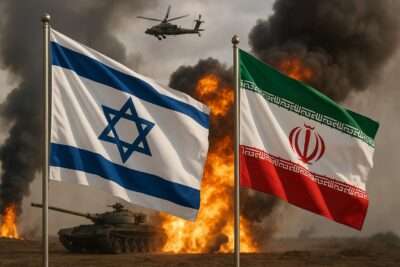What happened on June 12–13, 2025
- Operation Rising Lion began with massive Israeli airstrikes across Iran, targeting key nuclear facilities (Natanz, Fordow, Isfahan), military bases, air-defense systems, ballistic missile launchers, and senior IRGC commanders
- Simultaneously, Operation Red Wedding (June 13) decapitated Iran’s military leadership, reportedly killing top IRGC generals like Salami, Bagheri, and Hajizadeh
- Operation Narnia moved swiftly to take out at least nine leading nuclear scientists in Tehran
- Intelligence-backed drone sabotage, orchestrated by Mossad from within Iran, disabled missile launchers and air-defense systems ahead of or during the strike
- Iran launched hundreds of drones and ballistic missiles at Israel in retaliation—over 1,000 drones and missiles were fired, though many were intercepted; around 550–1,000 were launched, with ≈70 missile/drone fragments landing in Syria
Syria’s Role & Its Relationship with Israel & Iran
- Arena & conduit
- Syria, long a battleground in the “shadow war” between Iran and Israel, often hosts Iranian military and proxy forces
- Posts in southern Syria—especially near Golan Heights—serve as launchpads for Iran-backed militias.
- Proxy posture post-Assad
- Since the Assad regime’s decline as of late 2024, Iran-backed groups in Syria have weakened; they have not launched major actions against Israel during this conflict
- Syria is fragile; Iranian proxies there remain marginalized and unwilling or unable to drastically challenge either Israel or the transitional government.
- Geography of conflict
- Much of Iran’s missile and drone volley headed toward Israeli territory, but about 70 debris fragments fell in Syria
- Israel’s operations included airstrikes inside Syria targeting Iranian assets and personnel (as occurred historically—including a 2024 consulate strike in Damascus) .
- Diplomatic balancing
- Post‑Assad Syria has engaged cautiously with Israel—reports mention “deconfliction talks” and even normalization overtures as Syria tries to balance pressures from Iran and Israel
- Israel, wary of Iranian entrenchment in Syria, has struck IRGC-linked positions—even as Syria signals openness to minimizing hostilities.
Summary
The June 12–13 strikes mark a dramatic escalation in the shadow war, combining covert (Mossad drones, covert targeting) and overt airstrikes to inflict serious damage on Iran’s nuclear and military infrastructure—and eliminate key leadership. Iran retaliated in kind, largely towards Israel, though Syria witnessed collateral impacts. In Syria, Iran’s weakened proxy networks and a tentative Syrian-Israeli diplomatic thaw suggest that Syria, while a theater of conflict, now plays a secondary role in the immediate conflict—caught between strategic alliances with Iran and pragmatic overtures toward Israel.

Leave a Reply